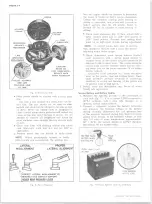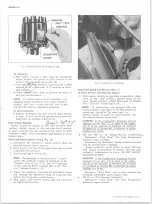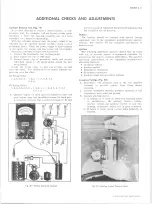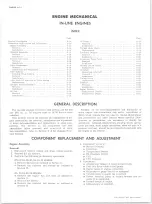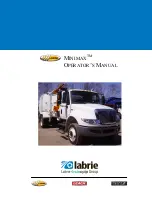
BRAKES 5-29
POWER BRAKES
GENERAL DESCRIPTION
The Power Brake Unit is a self-contained hydraulic
and vacuum unit, utilizing manifold vacuum and atmo
sphere pressure for its power.
This unit permits the use of a low brake pedal as well
as less pedal effort than is required with the conventional
(nonpower) hydraulic brake system. The unit is mounted
on the engine side of the fire wall and directly connected
to the brake pedal.
M A IN TEN AN C E A N D ADJUSTMENTS
Inspections
1. Check vacuum line and vacuum line connections as
well as vacuum check valve in front shell of power
unit for possible vacuum loss.
2. Inspect all hydraulic lines and connections at the
wheel cylinders and main cylinder for possible
hydraulic leaks.
3. Check brake assemblies for scored drums, grease
or brake fluid on linings, worn or glazed linings,
and make necessary adjustments.
4. Check brake fluid level in the hydraulic reservoirs.
The reservoirs should be filled to the levels shown
in Figure 7.
5. Check for loose mounting bolts at main cylinder and
at power section.
6. Check air cleaner filter in power piston extension
and replace filter if necessary.
7. Check brake pedal for binding and misalignment
between pedal and push rod.
Lubrication
The power brake unit is lubricated at assembly and
needs no further lubrication other than maintaining
normal reservoir fluid level. The reservoir should be
filled as described in this section.
Bleeding Inspections
The power system may be bled manually or with a
pressure bleeder as outlined in this section. Use only
GM Supreme 11 Brake Fluid or equivalent. Do not use
the power assist while bleeding. The engine should not be
running and the vacuum reserve should be reduced to
zero by applying the brake several times before starting
the bleeding procedure.
Air Cleaner Service
Servicing of the air cleaner is recommended and
the element replaced when restriction becomes severe
enough to affect power brake response. At any other
time, if cleaning of the filter is felt necessary, it should
be shaken free of dirt or washed in soap and water and
thoroughly dried.
CO MPONENT PARTS REPLACEMENT
Removal from Vehicle
1. Disconnect the brake lines from the two master
cylinder hydraulic outlets. Cover brake line fittings
to prevent dust and dirt from entering brake lines.
2. Disconnect the vacuum hose from the vacuum check
valve on the front housing of the power head. Plug
vacuum hose to prevent dust and dirt from entering
hose.
3. Disconnect the power brake push rod from the brake
pedal.
4. Remove the four nuts (inside vehicle) from the mount
ing studs which hold the power brake to the firewall.
5. Carry the power brake to a clean work area and
clean the exterior of the power brake prior to
disassembly.
Installation
1. Mount power brake assembly to dash.
NOTE:
All brake attachments are important at
taching parts in that they could affect the per
formance of vital components and systems, and/
or could result in major repair expense. They
must be replaced with parts of the same part
numbers or with equivalent parts if replacement
becomes necessary. Do not use replacement
parts of lesser quality or substitute design.
Torque values must be used as specified during
reassembly to assure proper retention of these
parts.
2. Connect power brake push rod to brake pedal.
3. Connect vacuum hose to vacuum check valve.
4. Connect brake lines to main cylinder outlets.
5. Bleed brakes as necessary and fill fluid reservoirs
to within 1/4” of top of the reservoirs.
10-30 CHEVROLET TRUCK SERVICE MANUAL
Summary of Contents for 10 1971 Series
Page 1: ......
Page 96: ......
Page 100: ...10 30 CHEVROLET TRUCK SERVICE MANUAL Fig 4 10 30 Series Truck Frame FRAME 2 4 ...
Page 120: ......
Page 203: ...ENGINE 6 25 Fig 22L Engine Mounts 10 30 CHEVROLET TRUCK SERVICE MANUAL ...
Page 215: ...ENGINE 6 37 REAR M O U NT Fig 21V Engine Mounts 10 30 CHEVROLET TRUCK SERVICE MANUAL ...
Page 218: ......
Page 249: ......
Page 324: ......
Page 340: ......
Page 365: ...10 30 CHEVROLET TRUCK SERVICE MANUAL Fig 43 Power Steering Pump M ounting STEERING 9 25 ...
Page 368: ......
Page 386: ......
Page 390: ...ELECTRICAL BODY AND CHASSIS 12 4 10 30 CHEVROLET TRUCK SERVICE MANUAL ...
Page 391: ......
Page 428: ......
Page 432: ......
Page 449: ...SPECIFICATIONS 9 10 30 CHEVROLET TRUCK SERVICE MANUAL ...
Page 463: ......
Page 464: ......
Page 465: ......
Page 466: ......




















